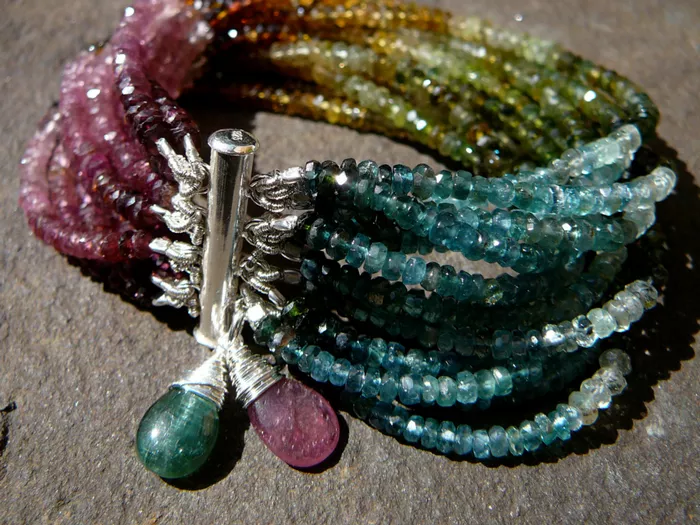Synthetic gemstones have become increasingly popular in recent years, offering consumers a more affordable and ethical alternative to natural gemstones. Among these lab-created gems, lab-created tourmaline stands out as a stunning and environmentally friendly option for jewelry enthusiasts. In this article, we’ll explore the fascinating world of lab-created tourmaline, including its production process, characteristics, and benefits.
Understanding Lab-Created Tourmaline
Tourmaline is a captivating gemstone prized for its wide range of colors, unique crystal formations, and versatility. It occurs naturally in various hues, including pink, green, blue, yellow, and multicolored varieties. However, the process of mining and extracting natural tourmaline can be labor-intensive and environmentally damaging.
Lab-created tourmaline, also known as synthetic or lab-grown tourmaline, offers a sustainable and ethical alternative to natural tourmaline. These synthetic gemstones are grown in a controlled laboratory environment using advanced techniques that mimic the natural processes of crystal formation. The result is a high-quality gemstone that exhibits the same physical and optical properties as natural tourmaline.
The Production Process of Lab-Created Tourmaline
The production process of lab-created tourmaline involves several steps, each carefully controlled to ensure the creation of gem-quality crystals. Here’s an overview of how lab-created tourmaline is made:
Seed Crystal Formation: The process begins with a small seed crystal of tourmaline, which serves as the nucleus for crystal growth. This seed crystal is placed in a crucible containing a mixture of chemical compounds that mimic the composition of natural tourmaline.
High-Temperature Melting: The crucible is heated to high temperatures, causing the chemical compounds to melt and form a solution. This solution contains the necessary elements for tourmaline crystal growth, including aluminum, boron, silicon, and various trace elements responsible for the gemstone’s color.
Slow Cooling and Crystal Growth: The temperature of the solution is gradually lowered, allowing the dissolved elements to crystallize and form solid tourmaline crystals around the seed crystal. This process may take several days or weeks, depending on the desired size and quality of the final gemstone.
Crystal Harvesting and Cutting: Once the crystals have reached the desired size, they are carefully harvested from the crucible and prepared for cutting and faceting. Skilled lapidaries then cut and polish the lab-created tourmaline into various shapes and sizes, ready to be set into jewelry pieces.
Characteristics of Lab-Created Tourmaline
Lab-created tourmaline exhibits the same physical and optical properties as natural tourmaline, making it virtually indistinguishable from its mined counterpart to the naked eye. Here are some key characteristics of lab-created tourmaline:
Color: Lab-created tourmaline can be produced in a wide range of colors, including pink, green, blue, yellow, and multicolored varieties. The color is determined by the presence of trace elements within the crystal structure, which can be carefully controlled during the synthesis process.
Clarity: Lab-created tourmaline typically exhibits excellent clarity, with minimal internal inclusions or flaws. This clarity enhances the gemstone’s brilliance and transparency, allowing light to pass through and create stunning visual effects.
Hardness: Tourmaline is a relatively hard gemstone, with a Mohs hardness rating of 7 to 7.5 on the Mohs scale. Lab-created tourmaline shares this hardness rating, making it suitable for everyday wear in jewelry pieces such as rings, earrings, necklaces, and bracelets.
Brilliance and Fire: Lab-created tourmaline displays exceptional brilliance and fire, with the ability to reflect and refract light in dazzling patterns. This optical phenomenon adds to the gemstone’s beauty and allure, making it a popular choice for jewelry designs.
Ethical and Sustainable: One of the primary benefits of lab-created tourmaline is its ethical and sustainable production process. Unlike natural tourmaline, which may be mined under environmentally damaging conditions, lab-created tourmaline is grown in a controlled laboratory environment using minimal resources and energy.
Benefits of Lab-Created Tourmaline
There are several benefits to choosing lab-created tourmaline for your jewelry needs:
Affordability: Lab-created tourmaline is typically more affordable than natural tourmaline, making it accessible to a wider range of consumers. This affordability allows jewelry designers and enthusiasts to create stunning pieces without breaking the bank.
Consistency: Lab-created tourmaline offers consistency in color, clarity, and quality, ensuring that each gemstone meets the desired specifications. This consistency allows jewelry designers to create matching sets and cohesive designs with ease.
Environmentally Friendly: The production of lab-created tourmaline has a minimal environmental impact compared to traditional mining methods. By eliminating the need for mining, extraction, and transportation, lab-created tourmaline helps reduce habitat destruction, pollution, and carbon emissions associated with the gemstone industry.
Ethical Sourcing: Lab-created tourmaline provides an ethical alternative to natural tourmaline, which may be sourced from mines with questionable labor practices and environmental standards. By choosing lab-created tourmaline, consumers can support responsible and sustainable practices in the gemstone industry.
Versatility: Lab-created tourmaline is available in a wide range of colors, shapes, and sizes, making it suitable for a variety of jewelry designs and styles. Whether you prefer classic solitaire rings, modern pendant necklaces, or vintage-inspired earrings, lab-created tourmaline offers versatility and flexibility in jewelry design.
Conclusion
In conclusion, lab-created tourmaline offers a sustainable, ethical, and affordable alternative to natural tourmaline. Through advanced synthesis techniques, lab-grown tourmaline exhibits the same physical and optical properties as its mined counterpart, making it virtually indistinguishable to the naked eye. With its stunning colors, exceptional clarity, and environmental benefits, lab-created tourmaline is an excellent choice for jewelry designers, collectors, and consumers looking for beautiful and sustainable gemstone options. Whether you’re drawn to its vibrant hues, ethical sourcing, or affordability, lab-created tourmaline continues to revolutionize the world of synthetic gemstones and pave the way for a more responsible and environmentally friendly gemstone industry.


